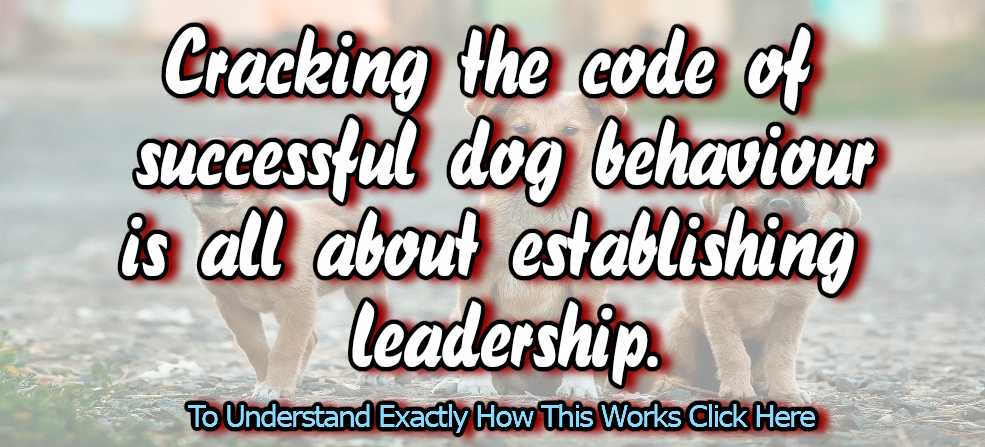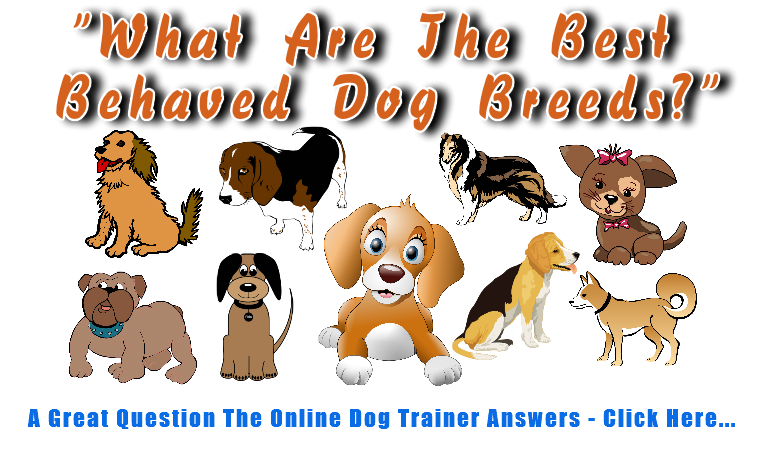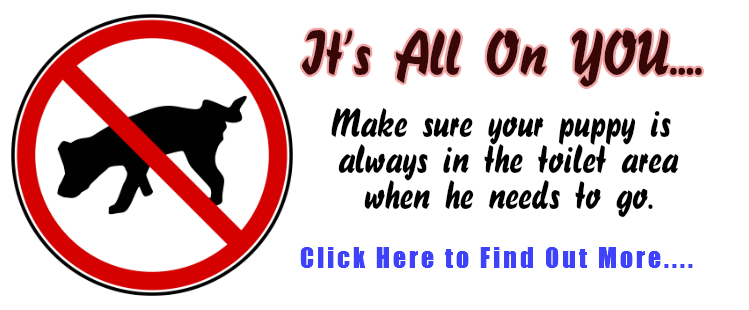Tribal Rod
How To Trim Puppy Nails
Many pet owners find it hard to trim their pup’s nails without stiff protests from the pet. This is because they have not groomed the dog for this monthly practice. You should give your puppy her first nail trim when she is about a week old in her new home.
After that, you should give her regular nail trimming so that she becomes accustomed to the routine.
Your puppy’s nails would grow big enough to be trimmed every 3 to 4 weeks. If you don’t trim the nails regularly, the overgrown nails have a chance to leave scratches on your body. These could be completely unintentional.
For the puppy, it’s more harmful to have overgrown nails. These nails can get entangled in carpets, sofa covers, or any other sundry objects in the home, leaving the puppy with painful injuries.
Overgrown nails have a tendency to bend and they can bend just into the paws giving your puppy a deformed leg position and possibly some wounds, too. So, how to trim puppy nails? In this article, we are going to present all that you need to know about the subject.
Read on!
Paw-Friendly Conditioning
If you have not clipped the nails of your dog before, it is good that you learn about it. The first thing is to make your dog ready for this regular personal hygiene practice. It will help you prevent some of the common problems that most pet owners face when trying to clip their dog’s nails.
To ensure that your dog does not become clipper-phobic, you should make paw handling a regular feature of all positive interactions with the dog – petting and treating.
You should follow the following steps to handle the paw of the puppy and build confidence in her.
Begin with handling her paws once or twice a day.
Nothing more!
Then, increase the number of times you handle her paws. For a week, give as much contact to the puppy’s paws as possible. Handle her paws and say: you are doing good.
The next week, give him a nice treat at the level of her eyes. As he reaches out for the treat, give her paws a rub with the clipper.
On a similar second occasion, take the clipper over one of her nails and quickly squeeze the handles to cut one of her nails – just one.
The next day you can aim for two nails. Gradually, you can cover all the nails.
If your dog has a white nail, it is easy for you to do the trimming without cutting too close to the nail bed. But if she has a dark nail, you will have to be careful because the nail bed may not be visible easily.
During this entire process, don’t try to calm your dog if she protests. Try to be with her than at her. If clipping is too scary for her, use the files until she becomes comfortable with the clippers. You may find this a bit tedious but it pays off in the long run when the dog understands the need for clipping their nails.
A clipper-phobic dog can be a hard thing to deal with.
Types Of Nail Trimming
There are two ways you can trim the nails of your puppy — with a clipper or with a file.
Clippers
The best clipper that you will find for your puppy could be a guillotine dog nail clipper. This is a no-fuss device to trim the nails of your puppy safely and comfortably. It isolates the nails clearly and performs a steady cut.
File
A file for filing the extra nail of your puppy can be bought from a pet store. It has the same look and feels that human nail files have. But its design is optimized for use on the dog’s nails. It has a sandpaper-like texture on a short stick or a rotating tool.
It files the nails not cut them. This makes it a safer option as there is no chance of cutting the nails more than they need to be.
Cautions
Clipping: When clipping the nails of your puppy, you should be careful not to clip too close to the nail bed. That can result in bleeding. You should aim to cut from the point the nails start to bend. If there are any instances of dewclaw, don’t forget to trim those extra nails.
Filing
While filing the nail of your pet, you should take help a family member to pet him during the process, and also offer treats from time to time. This would keep your dog calm throughout the process.
This is important initially when you are trying to familiarize yourself with the filing. You should aim to file the same length of the nail as you would aim to trim. Take small intervals between the filings.
Nail Trimming Tools
You may need different kinds of nail trimmers for different use cases. For example, you may have small puppies, small breed dogs, large breed dogs, and adult dogs. To trip the nails of dogs of each of these categories, you may need specialized clippers.
Depending on what kind of pet you have, you should check out the pet shop and find the right kind of trimmer for your pet.
To begin with, if the puppy is too small, a clipper will not be the best option to trim her nails. It might tear or pull the nail rather than giving it a clean cut. A human nail trimmer may work better for such tiny pets.
Guillotine trimmers have one blade in them and they are supposed to perform better on small breeds. It is because the nails of small breeds are smaller and less tough.
For adult dogs of a larger breed, clippers with two blades are supposed to be a better choice. They may resemble a pair of scissors or hedge clippers. They are extra strong to deal with extra tough and large nails.
However, at the practical level, you may use what best suits your pets. A skilled person can use any of these nail trimmers on any of the dog types.
Final Thoughts
Overgrown nails are harmful to both you and your dog. Clipping the nails of your puppy regularly is a good practice that both you and your dog should adopt. To clip the nails without any problem, you need to groom your dog and also use the right tools and techniques.
We hope this guide would help you with these points.
How to Prepare For a Puppy
Bringing a new puppy into the family is without a doubt an exciting experience that will bring joy and happiness to you and your loved ones. However, it also represents a new responsibility because you are going to take care of living life so you should get prepared for the hard work that comes with welcoming the new family member.
Here are some tips that will help you prepare for a new puppy.
Puppy-Proof Your Home
A puppy is an expert in chewing and eating things, including your clothes, furniture, cables, and books. Pick things up off the floor and don’t let anything in a place where your dog can easily them, pay special attention to what could choke or electrocute the pup. Secure sharp objects such as knives, scissors, and razors.
Install stairs gates will help to protect your belongings while also minimize the risk of falls or other injuries to your dog. Keep the doors and windows closed all the time to prevent the puppy from escaping or falling out.
Your garden is another place that you need to puppy-proof unless you want your furry friend to destroy your favorite plants. Fence.off the plants that you don’t want your puppy to destroy and avoid to have ones that could intoxicate your new little friend. Some of these plants include Lily, tomatoes, foxglove. Never let your puppy alone outside and set an area in the yard where they can be.
Discuss With the Family About the Puppy Rules
If there is more than one person living in your home you should discuss with them the new rules for the puppy. This will make the training process easier and more consistent, and the puppy will adapt to its new environment faster. Some of the most important things you should discuss are:
- Where will the puppy sleep?
- Who will feed the puppy three to four times a day?
- Does the puppy have permission to be on the sofa or other furniture?
- How will you correct the puppies when they make a mistake?
- Who will be in charge of the puppy veterinary appointments and take it there?
- Create a vocabulary list to avoid creating confusion for the dog.
You should teach your children about the basics of having a puppy, tell them to have a calm mood when the puppy arrives since loud strangers can be overwhelming for the dog. Kids should know how to handle the puppy including not to disturb it when is eating or sleeping.
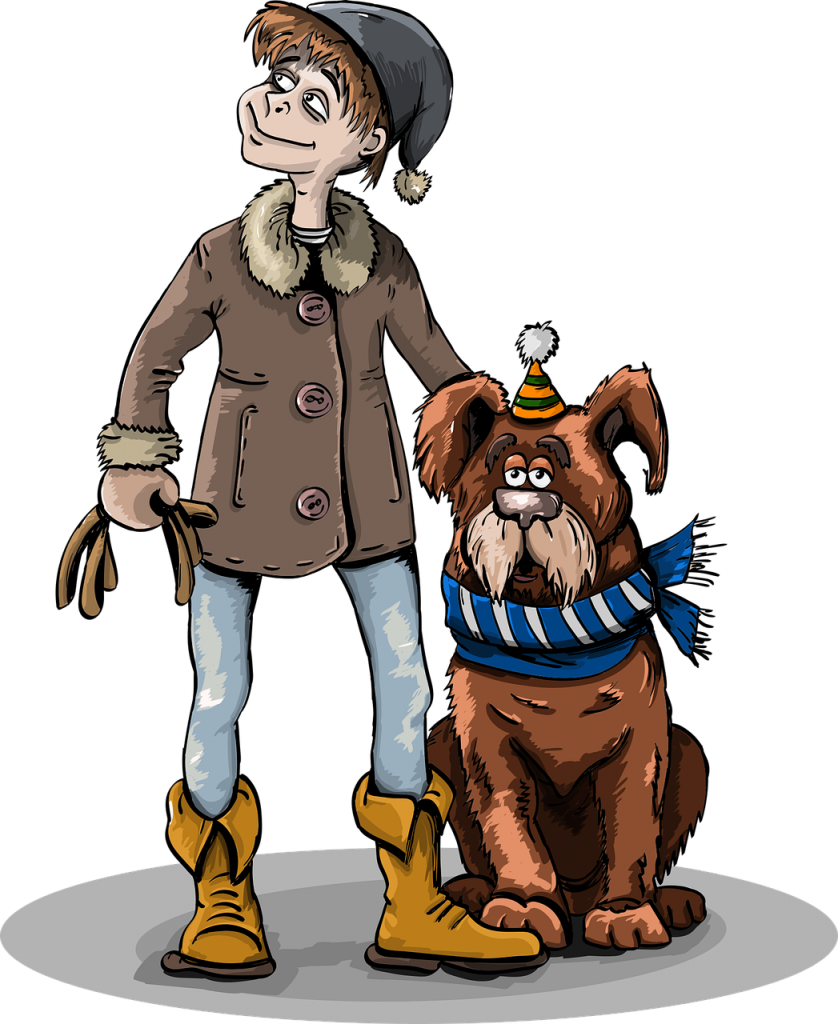
Create a Shopping List
You will have to buy a lot of equipment and supplies to make sure your puppy comfortable and adapt faster to its new environment. Here’s a list of what you should buy:
- A crate: This is an ideal place for your dog to sleep and keep it confined when you can’t supervise it.
- ID tag: All dogs should wear a tag on their collar including personal information such as the owner’s name, address, and phone number. You should also consider microchipping, it is the most effective way to ensure that you can reunite with your dog whenever it goes missing.
- A collar and leash: To take your dog for a walk outdoors and control it.
- Baby gates: To restrain access to certain areas of the house.
- Food and water bowls: Choose bowls that are easy to clean and durable so the puppy can’t damage them by chewing. The puppy always needs to have access to fresh and clean water.
- Things to clean up puppy disasters: This includes buying paper towels, cleaning cloths, and cleaning agents.
- Grooming tools: Ask the breeder or the pet shop staff for advice regarding the type of coat of your puppy as well as the comb, brushes, shampoo, conditioner, and nail clippers.
- Something to chew on: Your dog will need something to chew in order to test their teeth. It is a great way to keep your dog from biting the furniture or clothing. Make sure the chews aren’t too tough for your teeth and are durable.
- Toys: Your puppy should have plenty of different toys to make the training sessions more interactive and make him exercise.
- Food: Consult with your breeder or veterinarian about the right diet for your puppy and the diet he followed during his time at the rescue center. Maintain the same diet for at least one week and gradually change it to prevent gastrointestinal issues in the furry friend. Include some treats on its diet to provide positive reinforcement.
Arrange the Puppy Veterinary Care
Ask your dog owners relatives and friends to recommend a veterinarian or use a vet local finder. The veterinary is an important professional that will be crucial for your puppy’s well-being. It should be someone with the necessary licenses and certifications, as well as someone you feel comfortable with.
The practice should be close to your home and have its own emergency cover if not find where to go for an out-or-hours emergency. As soon as your puppy gets to your home take him to the vet, make sure to discuss things such as vaccinations and insurance policies.
Set up regular appointments with the vet to check-up the dog, follow the schedule of vaccinations, learn the health risks of the specific breeds, and take all the necessary preventative steps for diseases like Lyme disease. Your vet will also give you a solution to deal with fleas, mites, parasites, and ticks.
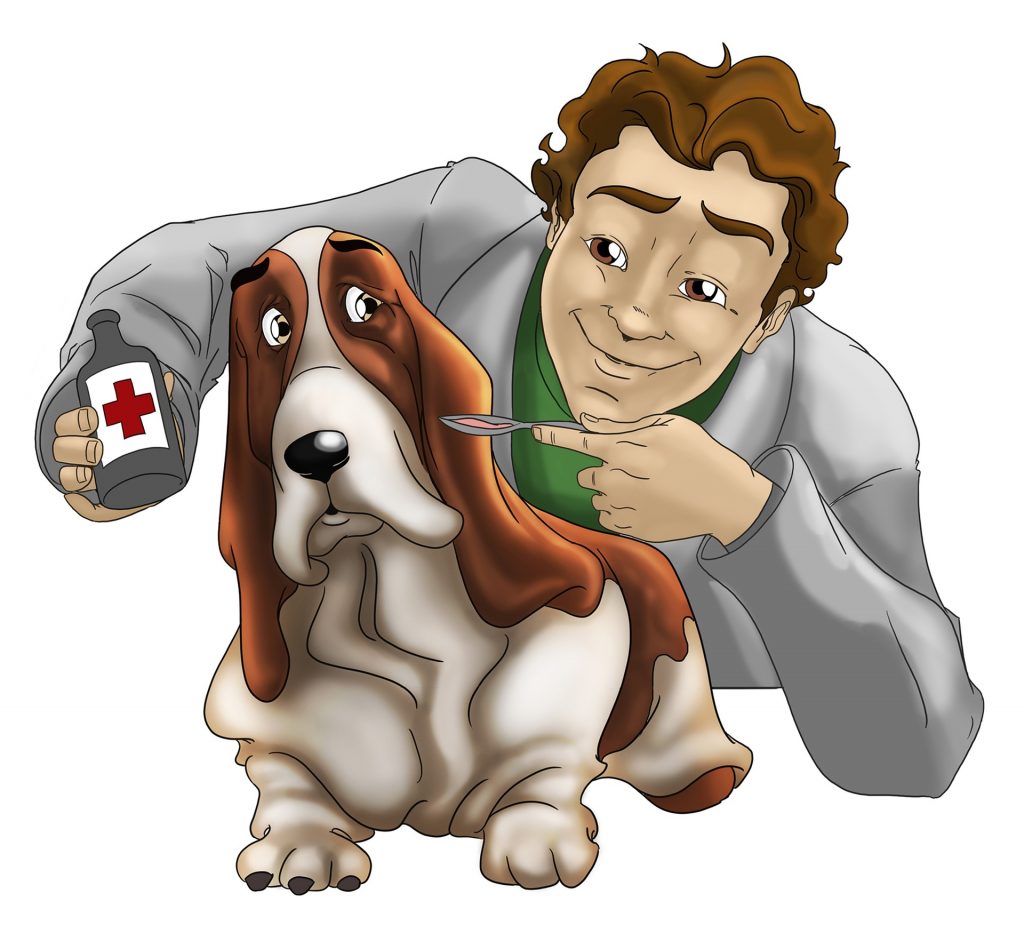
Puppy Training
You can take charge of the puppy training by yourself but it is also recommended to get your puppy into professional puppy training classes. Your dog will learn faster and also get the opportunity to socialize with other dogs. You can ask the dog trainer questions about the right way to train your dog which is way better than relying on Google to answer your questions.
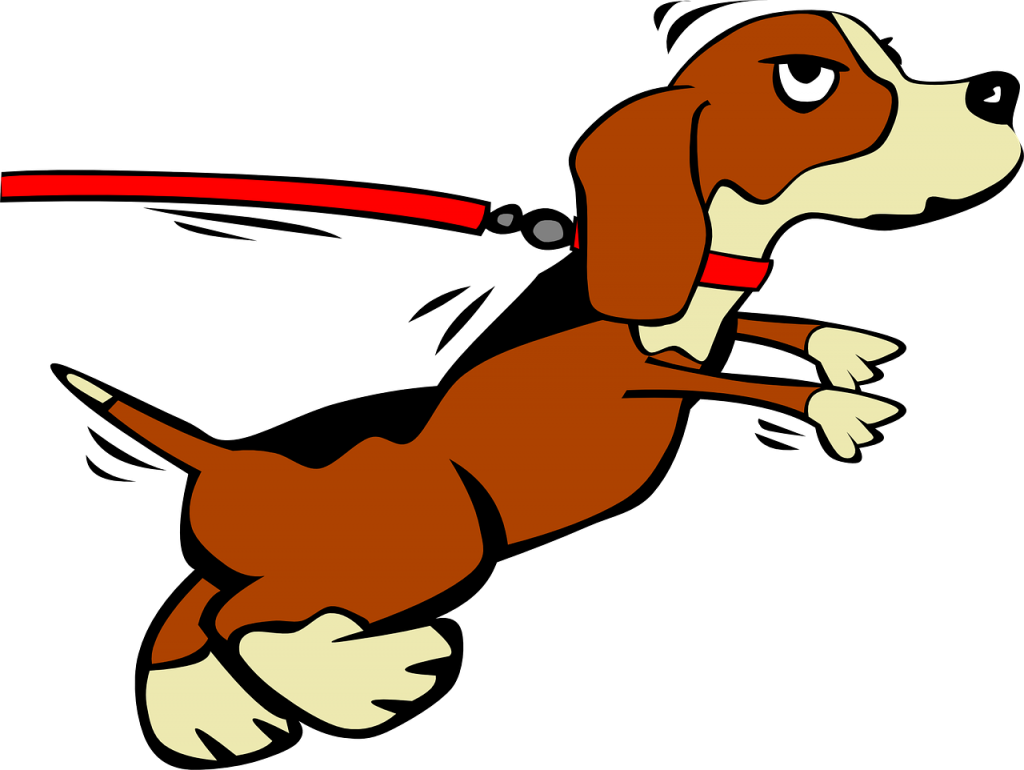
Final Thoughts
Following the previous tips will help you prepare to get a puppy and make the experience more joyful. You are about to experience one of the greatest moments of your life and create a strong bond with a living creature.
How To Pick A Puppy From A Litter
Once you have made up your mind to bring home a puppy pet, the next big task is to find a puppy that will grow up as a well-behaved dog in your home. You need to like the puppy and its demeanors. In the same vein, your puppy needs to like you and your family members.
For trouble-free compatibility, you should check the personality traits of the puppy you are choosing for adoption. There is nothing called a ‘puppy test’ that can foretell how the puppy is going to behave.
However, there are some traits that you may pick up looking at the puppy and how it behaves with the rest of the litter. These traits can be an indicator of how the pup is going to be.
At this stage, you should have researched the different breed types and the one that you want to bring home. Now, the question is how to pick a puppy from a litter?
Pick One From The Breeder, Not A Pet Store
You may find attractive puppies in the showcase of your neighborhood pet shops. You may tempt to buy one from there. But that’s not the right way to pick your puppy.
In the pet shop, the puppies are kept in their small cages where you have little chance to see how they interact with other mates in the litter.
The puppies sold in the store are born in puppy mills to dogs that are kept in pitiable conditions in cages all through their lives. Picking a puppy from the breeder is always a better option.
The living condition at the breeder is better where the litter is allowed to interact with the mother dog as well as the littermates. This helps the puppy pick up and develop his natural personality traits.
Why Is It Important To Know The Personality Traits Of The Puppy?
You want to bring home a puppy that grows up as a healthy, friendly, and trustworthy dog. You don’t want to bring home a pup that’s going to grow into a dominant, rebel, or violent dog. You can watch the puppies interact with other littermates and spot their personality traits.
Looking at them interacting, playing, and fighting, you can understand their individual demeanor and temperament. This would finally let you know which of the puppies a perfect fit for your home.
Visiting The Breeder
If you are far behind in the queue at the breeder, by the time your turn comes to pick your puppy, some of them would have already been picked.
For the healthiest puppy, you should pick from the third litter of a bitch with the same stud. Looking at the previous litter, you would know that the bitch and the stud had been giving birth to healthy pups.
The best puppies would be friendly and curious. They should show trust to their littermates and you. They should stare at you, get into your lap, gather around your feet, and tug at your shoes and trousers.
Check out shy and aggressive behavior in the puppies. These traits could get established in their genes and would become stronger when they grow up.
A shy puppy may not trust anyone while an aggressive puppy is a more aggressive dog. Both will show anti-social behavior when they grow up.
Now let’s identify the puppy for you…
A litter of puppies has many personality types – shy and aggressive are just a few of them. Here are some of the types you can expect to encounter at the breeder’s facility.
Dominant Pup
A dominant pup is also the bully pup. He can be social and interactive but he would not lose an opportunity to steal a toy or pick a fight. He would love to climb on other pup’s back and try to cross over the enclosure. This kind of behavior highlights willpower, determination, and smartness.
Will such a puppy become a sociable and well-behaved house dog when it grows up? Perhaps not! This kind of personality makes a dog unfit for a domesticated life. Keeping the puppy from more of this kind of behavior as it grows up will demand more time and attention from you.
This may cause stress to you as well as others in the home.
Rebel Pup
The rebel pup can come disguised in some very sweet demeanors – playful, intelligent, and interactive. It can show high levels of energy and a more active temperament. A rebel pup is a lot similar to a dominant pup but it is less belligerent and more sensitive.
This kind of pup is not obstinate. It is also more sociable and personable. If you are an active person who likes to spend time and play with pets, this can be a good companion. But they may not be the perfect fit in a home where there are small kids.
Independent Pup
Can you spot a puppy who is content with himself, his toys, and his errands? He is also playful, interactive, and overall happy. This kind of puppy is a good match for your home if you have older people living in a calm and stable setup.
Eager to Please Pup
There are some pups excited and eager to please you. If such a pup has none of the traits mentioned above, it can become a great home dog. But you would need to be firm with him and give proper training along with reinforcement.
Relaxed Pup
This kind of pup shows a balance of different traits. They are interactive, playful, relaxed, and intelligent. But they don’t overly show any of these traits. They can be an ideal companion dog for an owner who is cool and relaxed. They can live happily with kids.
Timid Pup
This kind of puppy is a shy puppy. It does not put up a great protest or fight. It will show a submissive posture like making an arch of their back or creeping on their bellies. It will take a great deal of patience and training to get this kind of pup to regain its self-esteem.
This could be a good companion for a single owner who could spend time with it.
Final Thoughts
How to pick a puppy from a litter? We have discussed many points about a puppy’s personality traits. It is possible to identify these traits and visualize how the puppy would behave as it grows. Based on what kind of home you have in terms of kids, elderly people, etc., you can pick a puppy from the litter that has a chance to grow into a healthy, trustworthy, and well-behaved dog.
The Best Puppy Breeds For Families
Sweet, loyal, and protective, dogs are the most beloved pets on the planet for a reason. Canine companions love their human owners unconditionally. Their loving nature makes them the perfect domestic pets that thrive in family environments. However, not all dogs are the same in terms of temperament and care.
Below, we have compiled a list of the ten most family-friendly dog breeds that will ease your search for a new puppy.

Golden Retriever
Goldens are the ultimate family dogs, incredibly sweet, loyal, and patient. Due to their even temper, they will make great cuddle buddies for even the smallest humans in your family. Aside from being good with small children, golden retrievers make for excellent comfort and service pets.
These affectionate creatures are very active and would love nothing more than to play a game of fetch with their owners. Care wise you need to brush these majestic beauties twice weekly to maintain their lush coats. If you are looking for a fun-loving yet obedient puppy, this is the best pet for you.
Labrador Retriever
Labradors are easily the favorite dog breed worldwide. A top choice for family dogs, the labs earn their popularity rank because they are loving, reliable, and devoted pets. Labrador pups are also incredibly smart, which makes them easily trainable. Due to their patience and playfulness, labrador retrievers are an excellent match for children and other animals as well.
This breed is also highly active and needs a lot of space for running and playtime. Swimming is one of their favorite activities, as well as spending time with their family. These pups have short coats, which require a weekly combing session, and they tend to shed a lot.
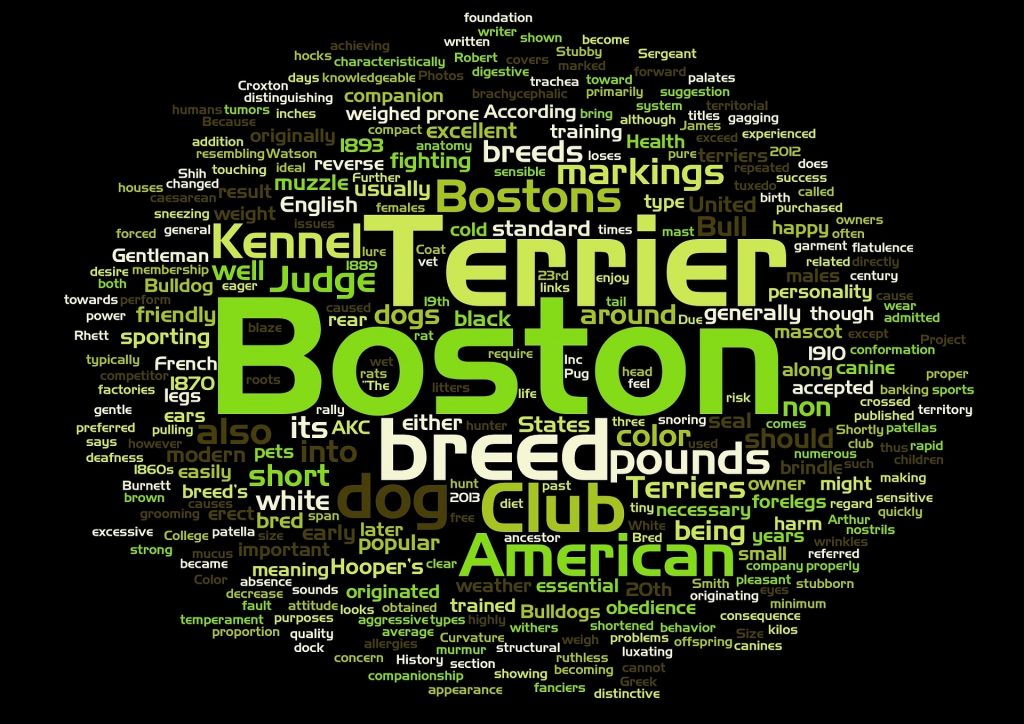
Newfoundland
The Newfoundland breed is known for its sweetness, devotion, and love for children. With a sweet nickname like “Nature’s Babysitter,” these gentle giants will win over the affection of all family members. Kind-tempered and patient, this large breed is highly suited for families that have the space to keep an energetic dog. Their long coats require regular grooming as they tend to shed excessively.
These well-behaved companions are also great swimmers that have saved lives in dangerous situations. They are very task-oriented, which means they love a challenge that can keep them occupied.
Poodle
Poodles are some of the smartest dog breeds you can find. They do very well with training and quickly pick up any rules and boundaries you set out for them. These proud beauties are pretty easy going and caring, which makes them excellent family pets.
Since poodles don’t shed a lot, they are the perfect pet for children with allergies. There are standard-sized poodles, but also smaller breeds, so you can make your choice based on your living situation. Both smaller and larger poodles are kid-friendly, obedient, and playful.
Beagles
With their drooping ears and pleading brown eyes, beagles make for adorable pets. This relaxed breed is at their happiest when they are tracking an appealing scent. Their small size and docile temper make them marvelous family dogs. The beagles were bred as scent hounds to hunt small animals like rabbits and hares.
However, nowadays, you will find plenty of these puppies living as furry companions for kids and adults. When it comes to training, they can be a little stubborn, but they make up for it with their merry disposition and loving nature. They shed quite a bit, so their furs require regular upkeep.
Irish Setter
With stunning red coats and playful energy, the Irish Setters are great at spreading joy and positivity in their midst. This gorgeous breed loves the company of people and pairs well with energetic children. An Irish Setter puppy is great for homeowners with yards, and they will also love greeting new people that visit your home.
These smart puppies are easy to train, and they hate being alone. An energetic puppy, such as an Irish Setter, is an excellent choice for families with an active lifestyle. Their long coats need regular grooming and brushing.
Border Collie
This particular breed of Collie has a very gentle demeanor and gets along great with children. The Border Collie is highly intelligent and easy to train, which makes it a splendid choice for families that have little experience with dogs. As a predictable breed, collies rarely misbehave and love to please and protect their family.
They love tasks and activities that keep their intelligent minds occupied. With their high levels of energy, they need to lead an active life to remain happy and stimulated. To keep their long coats in top shape, they require regular grooming.
Bulldog
Armed with patience, bulldogs are your best bet if you’re looking for a pet for kids. Their sturdy build makes them an excellent companion for your child, as well as their docile manner. Bulldogs are pretty laid-back and not as energetic as other dogs.
They have earned their reputation as excellent family dogs due to their ability to form strong bonds with children, but they also get along with other dogs and pets. Bulldogs are also pretty adaptable and comfortable in both large and small living situations.
The only downside to bulldogs is that they require high maintenance, such as teeth cleaning. On the other hand, their coats need minimal maintenance.
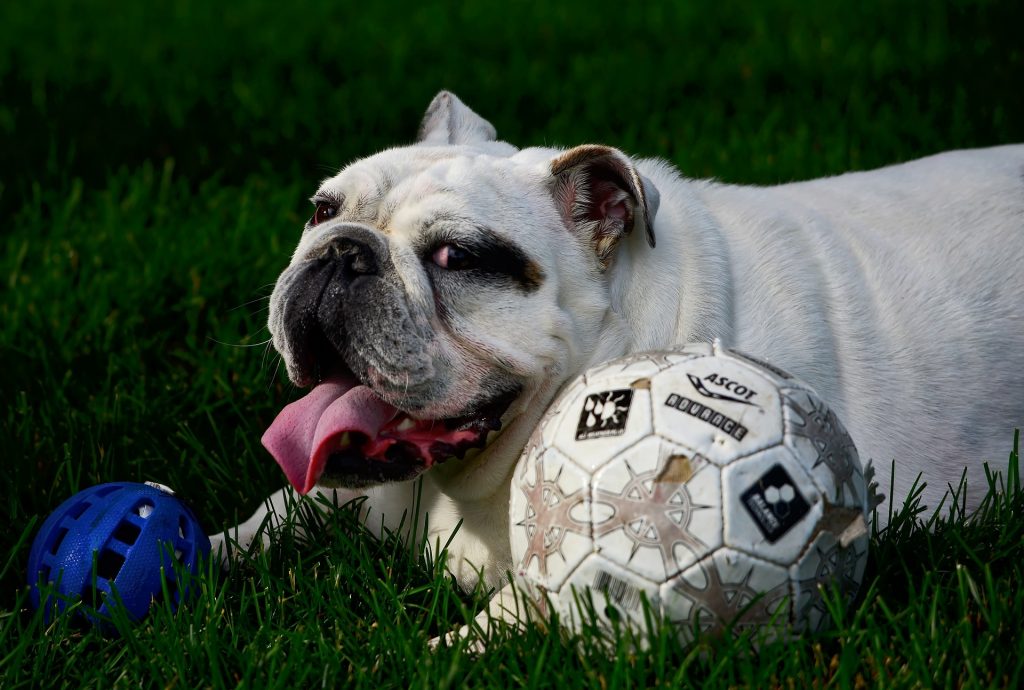
Pug
People-oriented and charming, pugs are great for families with children. These small dogs do not need a big backyard but can live comfortably in a big house or a small apartment. Perfect for families with a laidback lifestyle, the pug breed will make a great addition to your relaxed family nights. They do love their beauty sleep, sleeping an average of 14 hours per day. Pugs are very observant and quick learners, which makes them highly trainable. They mix well with other animals and require small amounts of maintenance, such as regular brushing.
Each of these breeds has its unique qualities, strengths, and weaknesses. Choosing the right puppy for your family will depend on your specific priorities, whether that is low maintenance, high energy, or a friendly demeanor.
Why is My Puppy Crying
Newborn babies communicate their needs by crying, and so does your puppy! But how do you know what specific reason your puppy is crying?
And what if all his or her basic needs are already met? How you respond to your puppy crying is important!
Remember, your puppy is not crying to annoy you, but rather to express himself and to try and get his needs met in the only way he knows how, so don’t yell.
If you yell, your puppy might stop crying, but it is likely he will just be hurt and confused.
If you feel yourself getting ready to yell, there is nothing wrong with taking a break…just make sure your puppy is in the crate or another safe location before leaving. The best way to deal with your puppy crying is to figure out the specific need or want he has and addressing it for him.
Once you meet your puppy’s needs, the crying should thankfully stop soon after and maybe even immediately. Below we will go through all the main reasons your puppy may be crying and what you can do to help.
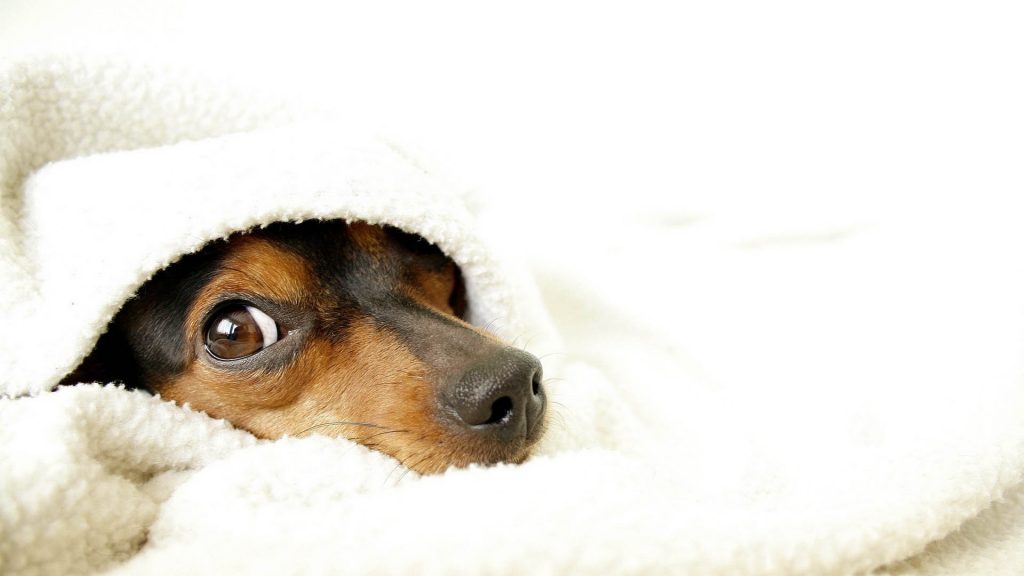
SICKNESS
When we as humans feel sick or hurt, sometimes we cry, and the same is true for your puppy. If he or she is crying or whimpering on a regular basis, and it appears like all the other needs are met, your puppy might be experiencing some pain or discomfort.
If your puppy is sick, you will probably notice other symptoms as well so pay attention to things like loss of appetite, vomiting, diarrhea, lethargy, fast breathing, excessive licking, biting, or scratching, or dizziness.
Another possible symptom is that if your puppy is usually very affectionate, he may start to withdraw and avoid being touched.
If you think your puppy is sick, it is important to get to the vet as soon as possible. With older dogs, you do not always have to rush to the vet at the first sign of illness, but puppies do not yet have the immune system, so waiting can be risky,
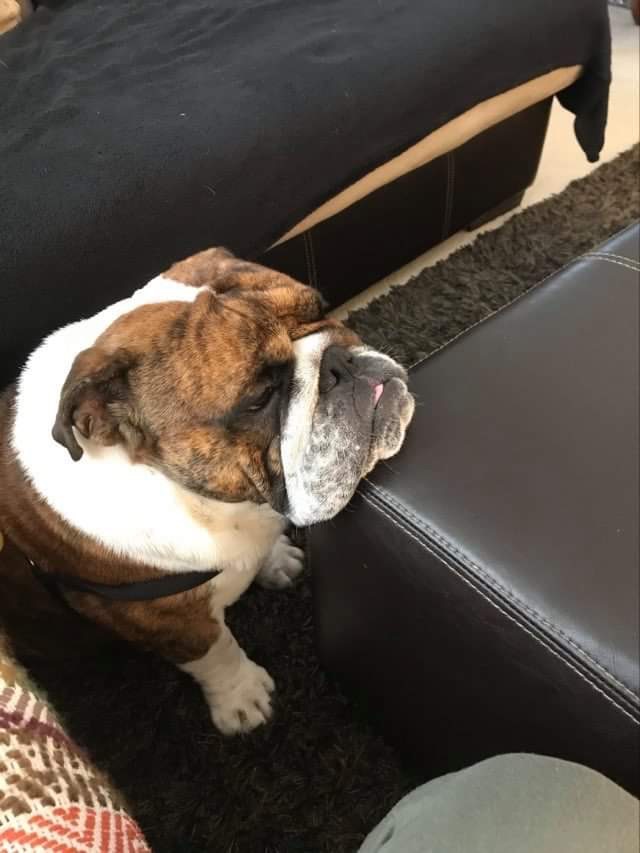
LONELINESS
Dogs are social creatures, so they can get lonely at any age, but especially when they are puppies because they are adjusting from having their mother and siblings constantly around them. If your puppy is lonely, try to keep him with you throughout the day, even if you are busy.
It can be as simple as putting their crate next to you in the kitchen while you are cooking dinner or in the office while you are working.
An additional benefit is a fact that your puppy is less likely to have accidents if he is right next to you. Loneliness is probably less of the problem if you have multiple dogs.
FEAR
As your puppy is exploring and discovering new things, he may become more fearful of things that he has never been exposed to before.
Sometimes, they even develop fear periods where they become afraid of things that they were not afraid of previously, and the fear causes them to cry.
Don’t worry, this is completely normal, but pay attention to body language, so you know when your puppy is afraid. If you notice your puppy is afraid, remove him from the situation and try again with a less intense version later.
HUNGER
Does your puppy cry more before mealtime than any other time of the day? If that is the case, your puppy is probably crying because he is hungry. T
his could just be in preparation for his next meal, or there is a chance that he is not getting enough food. Most dog food has different recommendations based on size and weight, but it is sometimes better to pay attention to your dog’s body rather than the label.
If your dog is too skinny, give him more food. If your dog is a little overweight, give him a little less.
BOREDOM
Puppies have a lot of energy, so when they get bored, they sometimes let that energy out by crying or barking a lot. In order to make sure your puppy does not get bored, you need to provide it with plenty of both mental and physical stimulation.
Overall, make sure your puppy gets plenty of exercise and playtime throughout the day, but on days when you do not have as much spare time to play, try out a food puzzle toy. These toys keep them occupied and stimulates their minds.


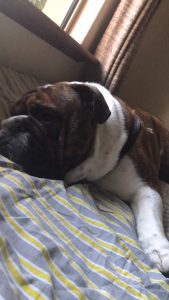
WANT FOR AFFECTION
Puppies love attention and affection, so they will cry to get it. This happens a lot when a person they love first comes home, so it is important to spend time greeting your puppy when you get there, even if it is just for a moment. However, one thing to keep in mind is that you do not want to give your puppy too much control.
If all his needs are met, you do not want to award demanding behavior, so sometimes, if your dog is crying or being demanding, it is best to wait a minute until he calms down before giving him attention and affection.
This may feel mean at the moment, but in the end, it will help him learn good behavior. Remember, all puppies cry, and whimper and bark, and all three are totally normal and okay. The majority of the time it is nothing to be overly concerned about, so do not panic.
If your puppy is crying, work through the above list one at a time and make sure all his needs are met. Chances are if he is crying a lot, one of them is not, and as soon as you fix it, the crying will stop.
Training a new puppy can be an exhausting process, but as you bond with your sweet, furry friend, it will be well worth it. Just remember to give yourself and your puppy a little bit of extra patience and take a break if you need it.
Putting Together Your Puppy Starter Kit
If you have decided to buy yourself a new pup or even adopt one, Congratulations! Adopting one is a great deal for an abandoned pup, and there is no denying that dogs make a person’s life happy and exciting.
Those pet lovers who are already an experienced pup-dad or pup-mom are quite acquainted with the requirements of having a dog. But for some of us, there is a chance of forgetting the nitty-gritty of having a new furry buddy.
Do not worry, we have found a way to save your money and time by providing you with the puppy starter kit.
What Is A Puppy Starter Kit?
Pet retailers either online or in the pet shops are now providing almost everything that your pup will require, all in one big box with major discounts. This is both convenient, inexpensive, and time-saving.
Additionally, the starter kit does all the heavy work by offering everything in a box. It is extremely annoying when you think you have bought everything and you come home to find that you have forgotten to buy that one main item your dog needs.
In this article, let us explore all the necessary things that your furry baby needs, especially when he arrives at your door. We are putting together your puppy starter kit for your convenience.
Puppy Food
If you have brought a pup home, you definitely want to give him the best possible life. And it starts with premium quality pup food. Try feeding him quality dry food that is specially made for your growing dogs.
But this is not as easy as it seems. There are several dog food brands on the market and choosing the best one can be quite challenging. No need to worry, all you have to is go through the ingredients.
First things first, look for real meat in your dog food. This means it has no unidentified meat or by-products. Do not feed foods containing corn, soy, or wheat. These cheap fillers lack nutritional value and they have no benefits for the growing pups.
Also, include fresh fruits and vegetables in your recipes.
Kennel and Crate
Buy a suitable size kennel for your puppy. They are great for transporting them from one place to another. If you have a larger breed, get an expandable kennel.
What is important to remember is that while buying a kennel or a crate for housetraining, the pup may require enough space to move around, stand up, lie back or turn around comfortably. If you buy a big kennel for your small pup, they will get room to do their business right at the corner or back and sleep in the front.
On the other hand, if you buy a small kennel for a big dog, it will not be comfortable and they may not enjoy staying in.
Leash and Collar
If you want to keep your dogs under control, the leash and collar are the right instruments to help you. You need to fit these correctly to avoid escaping. The collars or harnesses are adjustable and so they expandable as the dogs grow in size.
You can also get combo deals that include both the leash and the collar together and you can also buy them separately according to your taste and preference.
Toys, Treats, and Chews
Puppies are like children. They require toys and treats too. And sometimes, as dog-parents, you would also like to keep your dogs busy, wouldn’t you?
There are hundreds of toys, chews, and treats available on the market. Dog toys vary in textures from nubby, ropes, soft, etc and they are made keeping in mind the size of the dog.
An excellent choice for larger breeds such as Huskies and Labs is the Kong toys. They work amazingly for aggressive dogs who are chewers and need heavy-duty items.
The same thing applies to treats and chews. Before buying the toys, size them appropriately for the dogs to make sure that the toys do not pose to be a danger to their health.
Water and Food Bowls
It is quite obvious that your puppy will require his own water and food bowls to drink and eat from. You can use any water bowls either made from plastics, ceramic or stainless steel. Keep in mind that the bowls are not too deep because small puppies may find it hard to reach the water level.
Get an appropriate size for them and replace it when they grow up.
If you are going to have a big dog, you may start with a small food bowl and when your pup grows up, replace the bowl with a larger one. Puppies may find it hard to eat out of a large food bowl. So, let them enjoy food from small bowls.
Training Pads
Just like children, puppies also have accidents and there is to be worried or alarmed. This is why you need pee-pee pads in hand. They are extremely absorbent. They lock the urine in and does not leak. They are generally available in various sizes and the number of pads also vary based on the breed you have.
Various Grooming Items
Doggy toothbrushes, toothpaste, shampoo, combs, and toenail clippers are some of the necessary grooming items you will require for your dog to be healthy.
Start with the grooming process when your pup is still young since they need to be accustomed to the routine. Make sure that they are not scared when you groom them. It may cause them trauma and have an adverse impact on their emotions and psychology.
Pillows, Beds, and Throws
Some people love to keep their puppies like their children, on their furniture. But it is good to provide the dogs with their own bedding and sleeping spot. This gives both, the parent and the pup, some privacy. There are different varieties of pillows, beds, and throws, made of different materials.
So, buy according to your taste and the needs of your pup.
Conclusion
You may include more items in the puppy starter kit – sterilized bone, grooming brush or slicker brush, small blanket for your pup, a bib, heartworm medicines, and a dog tag for identification.
These kits are excellent for those who are getting themselves pups for the first time and they are money and time-saving too. Different brands have different kits. So, be aware of the items before choosing one.
Things to Consider While Purchasing a Puppy Shampoo
It is extremely important to maintain the health of the skin and coat of your puppy given that these are the primary organs which help them to stay away from the invasion of foreign elements. Cleaning the coat of your puppy using puppy shampoo will be the most effective way of making sure that your pet is able to maintain the health of his coat and skin in the best possible way.
Apart from this, in case you use a puppy shampoo, it will help the pooch to appear clean while smelling great as well.
You will come across lots of puppy shampoo for different breeds on the market and this can make it quite difficult for you to comprehend which one to opt for. In the following paragraphs, we have mentioned some essential guidelines on how to get hold of the proper puppy shampoo which will help you to make a sensible decision in the long run.
Is It Imperative To Purchase A Puppy Shampoo?
The majority of the puppy owners are not certain whether they will require a puppy shampoo or not. However, the reply to this will be in the affirmative. An adult dog, depending on the breed, might feature single or double coats which can be quite thick.
Nevertheless, puppies feature fluffier and softer fur which develops just like a single coat, and for this, they require a special shampoo designed for their fur. As a matter of fact, puppy shampoos have been formulated to match the requirements of fluffy and soft fur of the puppies.
According to some vets and dog owners, it is possible to use shampoos intended for adult canines on puppies; however, it is always imperative to verify whether the adult dog shampoos have been formulated for satisfying the requirements of the fur of your puppy.
It must not consist of any harmful ingredients and it should not likewise be a medicated shampoo.
Can Baby Shampoos Be Used?
Baby shampoo is another kind of shampoo which is important to consider whether they can be safely used on a puppy. It will be possible to safely use the baby shampoo on the puppy in case it has been made from natural ingredients and does not consist of any chemicals.
As compared to puppy shampoo, baby shampoo is usually more inexpensive; however, it is imperative to verify the ingredients before purchasing to make sure that it is safe. The skin and fur of a pooch is more alkaline as compared to that of a human which is usually more acidic.
For this reason, human shampoo should never be used on a puppy by any means.
The skin of humans is more acidic as compared to that of your dog and human shampoo has been formulated to work with human skin. In fact, the alkaline skin of a puppy requires a special shampoo. In case human shampoo is used on the puppy, it might lead to itchiness, redness, and soreness which can cause wounds that can be scratched by the puppy leading to infection in the long run.
Selecting The Proper Puppy Shampoo
You need to consider several aspects while selecting the appropriate puppy shampoo. The most essential thing is that this shampoo has been made for puppies and not for adult dogs or humans. The things to consider are as follows:
-
pH Level
As mentioned earlier, the skin of a puppy is more alkaline than that of a human which is more acidic. Because of this, it will be improper to use human shampoo on the puppy. The skin of an adult dog is somewhat more acidic as compared to that of a puppy, and therefore, it will be imperative to make certain that the puppy shampoo’s pH Level is correct and more alkaline.
-
An Absence Of Any Artificial Ingredient
It is a fact that you will not go for any product with artificial ingredients for your own infant, and it is just the same while selecting products for your puppy. Artificial ingredients might affect the skin of your puppy in an adverse manner since their organs and bodies are not that developed.
It will be advisable to avoid using artificial fragrances as well as coloring along with products including formaldehyde, phthalates, isothiazolinones, parabens, as well as nitrosamines.
-
Natural Fragrances
While washing your puppy you will like them to smell good later on. Nevertheless, a puppy shampoo with lots of fragrances is going to be artificial, and it will be prudent to avoid it since it can harm your puppy in the long run. In case you like your pup to smell good after bathing them, make sure to go for national fragrances like eucalyptus, chamomile, lavender, and rose.
You will definitely come across a substitute for an artificial fragrance which will enable your puppy to smell nice and will also not do them any harm whatsoever.
-
Skin Protective
The skin of your pup has the potential to safeguard itself by the secretion of natural oils by means of the skin cells onto its surface. On most occasions, you will like to have a shampoo that will be able to cleanse your puppy without interfering and washing off the natural oils.
This can be best performed by a natural shampoo consisting of ingredients like vitamin E, oatmeal, and aloe vera which are actually natural skin protectives. All these ingredients will help to safeguard the skin as well as the coat of your pet in the best possible way.
-
The Overall Health of Your Puppy
It might be possible for your puppy to have some specific skin ailments which have to be taken care of by the shampoo, and therefore, it is imperative to consider the overall health of your pet prior to purchasing it.
Although puppy shampoo for different breeds is actually formulated for the sensitive skin of the puppies, you will also be able to find shampoo for other skin conditions like fungal infections, seborrhea, allergies, and macrobiotic infections as well. In case you are not sure regarding which shampoo to opt for, make sure to consult the vet.
Conclusion
It is imperative to bathe your puppy from time to time, and a puppy shampoo will be the simplest and safest way to get the job done. It is important to look at the pH level of the shampoo which you are purchasing for your puppy and it also must not contain any artificial ingredient.
Hopefully, the guidelines mentioned above will help you to get hold of the most appropriate shampoo for your adorable puppy.
Litterbox Training A Puppy
Litter box training a puppy may seem a daunting task at first. However, once you create a daily routine for your puppy from the start, he will be more comfortable using it when nature calls.
Some dog owners train their pets to eliminate outside; however, there are times when you can’t let him out, or you live in an apartment.
Training your canine companion to discharge in his personal potty is convenient for you and your pet.
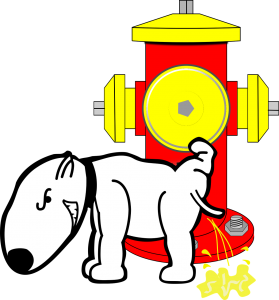
Getting The Right Equipment
Before taking steps to litter your train your puppy, make sure that you have the right equipment fist. All you need is something to contain the litter; a large plastic tub will suffice. You can purchase a more expensive tray that offers a self-cleaning function or one with a waste collecting system.
The right receptacle will have the following criteria:
- 1 It will be big enough for your puppy to turn around in.
- 2 The sides must be low enough for your pup to enter by himself but high enough to prevent him from peeing out of the tray if he lifts the leg.
You must provide litter for the container as they have more absorbent pellets. Dog litter varies from regular clay to odor-controlling activated charcoal. You can create your own odor neutralizer by sprinkling a handful of baking soda on the bottom of the container each time before filling it.
Whatever you choose to use, don’t use crystals, clumping, or any cat litter unless it’s completely natural. Ensure whatever you use to absorb your dog’s waste is 100% safe.
You will need a scoop, gloves, and a step-on trashcan to remove your pup’s waste each time he eliminates in his potty. Having the right equipment to hand makes this process easier.
Pet stain remover is useful, along with lots of rags. Pet stain remover is better to use than generic household cleaner because it neutralizes nasty pet smells rather than eliminating them, which discourages your canine from doing his business in is allocation.
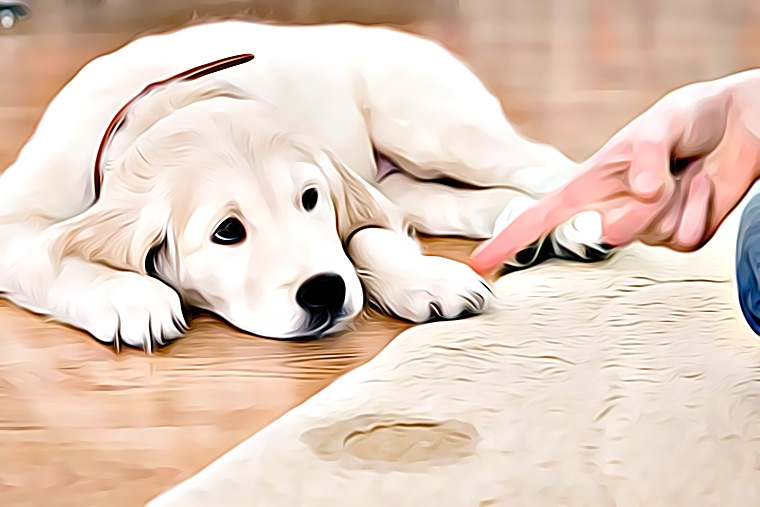
Choosing The Right Spot
It would help if you positioned the potty in an accessible spot that also offers your pooch some privacy. Consider placing the container in areas where he spends most of his time.
Ensure you consider the following precautions:
- Do not put the tray near your puppy’s food and water, as it discourages most pets from eliminating where they eat.
- Dogs tend to dig in their receptacle at the start of their training. You should place it in an area that won’t get too messy if any waste gets thrown out. Some dog owners put plastic paneling around the receptacle to keep the area tidy.
Getting Started
Once you have the right container with dog-safe litter, picked the area, and have all the necessary equipment to hand, you must familiarize your pet with the box by showing it to him. Study the following seven steps in litter training your four-legged friend:
- Your puppy must learn to go in the tray, by himself, on command before he learns to eliminate. Show him that it’s safe and fun. Do this by putting your pup in the container, giving the command “use the box,” and praising him for being there.
- Whenever your puppy leaves, put him back in. Repeat the command, offer praise, and show you appreciate him being in his box. Continue practicing until you can guide him inside while giving the command. Your puppy may enter when you say “use the box,” continue practicing until he gets in straight away on command, never forgetting to praise him.
- When your puppy pees where it’s forbidden, soak up the urine with paper, or take some of your dog’s poo and put it in the tray. This demonstrates that it’s okay to go potty there, encouraging him to go there when nature calls.
- Look out for clear signs that your pooch needs to eliminate, such as pacing, sniffing around, whining, or walking to the door, and send him to the container immediately. Say aloud, ” use the box,” this command should be used consistently to avoid accidents. Very young puppies should be brought every hour, in addition to after meals and naps. Puppies should be sent to the box first thing in the morning before you go to bed and before being left alone. By the time your little doggy is four months old, he should make it through the night without needing to pee.
- Make sure you never chastise your pal for accidents, as that will have a counterproductive effect. Shouting at your dog will only frighten him and make it will delay his progress. Consistency is the only way to train him. If you catch him in the middle of an accident, clap sharply to startle him; this should make him stop. Run with him to the litter box, reward him if he expels.
- Be sure to feed your pup on a regular schedule as this will lead to him eliminating at standard times.
- Watch your puppy closely to avoid accidents; you don’t want him getting used to doing his business in the house. Get familiar with the signs that he needs to go pee or poo.
Final Thoughts
During potty training, reward your four-legged when he uses it for its intended purpose. You should always accompany him and reward him with treats, a toy, and consistently praise. As previously mentioned, do not be harsh with your pet when he has an accident; being patient yet consistent will always work better for your little learner than yelling or belittling.
By all means, your dog should not get used to peeing or pooing where he pleases. Clapping loudly should get him to stop and then get him to the box quickly.
It would help if you cleaned out the tray every time your dog uses it as they don’t bury their waste like cats. Scoop out poo each time, and at least once a month, empty the box and clean it. Once your doggy goes himself without prompting, it’ll be worth all your effort.
Golden Retriever Puppy Training
When we have a dog and do not train it, we are wasting all its natural learning potential. Some breeds are smarter and learn faster than others. However, they all need proper training to make their best version shine and make life at home enjoyable and trouble-free.
The golden retriever is an extremely docile, intelligent dog with an enviable character. It is an ideal breed if we have children at home because they are very peaceful, playful, and not aggressive, which makes them a very reliable pet.
As we mentioned before, even though they are highly intelligent, they need to be trained to establish proper behavior. However, it will not be a difficult task since they learn quickly.
If you plan to bring a golden retriever puppy home or if you already have one but don’t know how to train it, you are in the right place. Below we will explain several tips that will be very useful to make the whole training process easier and practical.
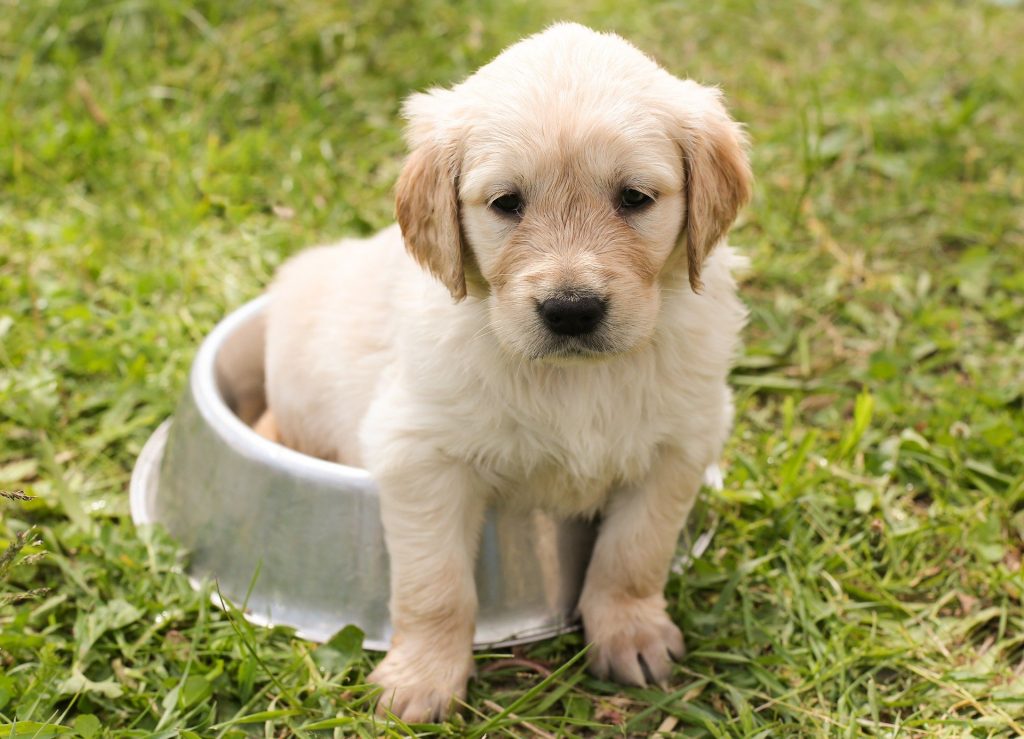
Golden Retriever Puppy Training
According to several dog training experts, a better training result can be achieved when starting at an early age, but this is not necessarily a limitation. In fact, excellent results can also be achieved when the dog is between six months and six years of age, but in these cases, we must be even more patient because the learning pace is a little slower.
A vital and fundamental factor is patience. Unfortunately, many people fail and desist from training their furry friends because they don’t see immediate results or in a short time and decide not to try anymore and the reality is that it is a process that requires patience and perseverance. Therefore, as experts recommend, it is better to start educating them when they are puppies.
For example, if we begin to train a golden retriever puppy between two and five months of age, we will be taking advantage of its maximum learning capacity. Besides, the pet itself will seek to continue learning new things.
When they are puppies they still do not produce certain hormones, and this helps the dog learn faster. This is because the deficit of hormones makes the puppy direct and focus all its attention on you, which will facilitate the training even if there are other people or other pets around.
Usually, golden retriever puppies will follow you wherever you move, and as their leader, they will take you as a reference. The puppy will behave and react as you do, both with other people and with other pets, so if we greet a friend happily, the dog will also do so, as well as if we are going to approach an animal, and we are nervous, our furry friend will also be nervous.

Awards, Rewards and Praise
You must have several prizes for your dog and give them to him once he listens to your orders. In this way, you will feel rewarded for the effort you are making and you will understand that you have done what your owner has asked you, and for that reason, you will be happy.
However, this type of food reward should be carried out only on special occasions and that what you give him to eat is something new for his palate. At the same time that you give him his reward, you must flatter him and show him affection.
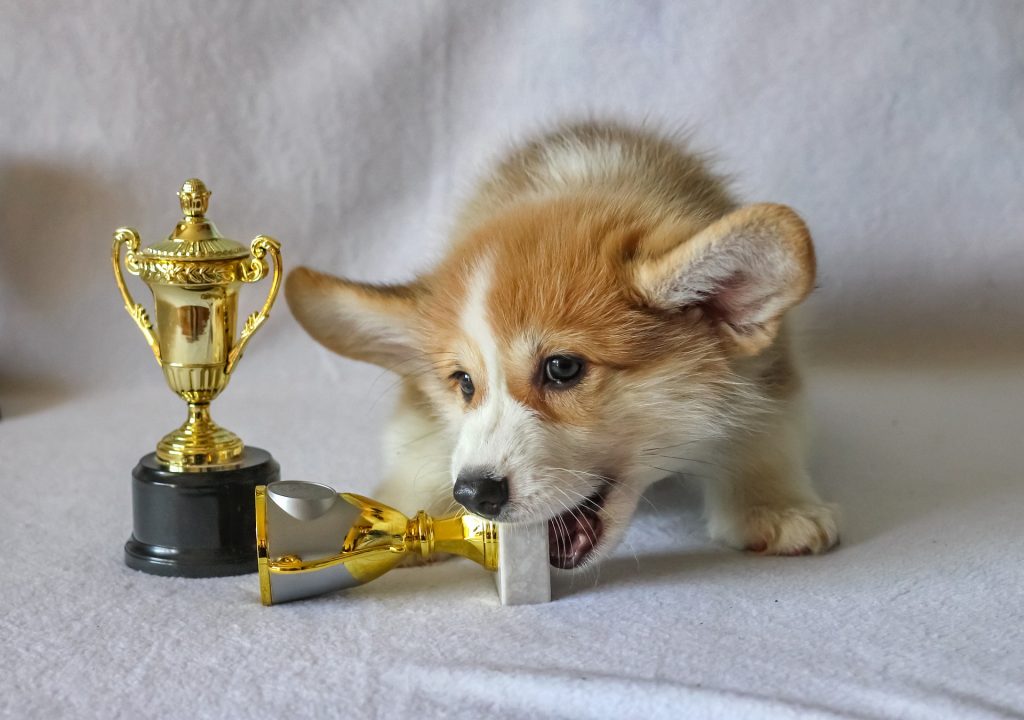
Basic Commands
To start training him, you must know the commands you can teach your golden retriever, be it a puppy or an adult. These are six of the easiest commands to teach:
- Call him to you
An easy way to start teaching your Golden Retriever is to go to the place where you are. For him to come to you, the ideal thing is for you to stand some distance away and have a prize ready in your hand, then you should give yourself a couple of pats on your thighs leaning forward and looking at him, right then you should tell him “Come!” and the name of your dog. Your puppy will come to you to look for its prize and this way it will be able to understand the command “Come” every time you indicate it. It is very important to reward him every time he obeys you, by being constant with this, he will learn faster.
- Sit down
For this command to be carried out, your pet needs to be moved around a bit so that it can understand it. You must select a prize and carry it at shoulder height, then move your dog’s back down slightly until he can sit up. Once he is seated, congratulate him and give him his prize. Then repeat this action adding the command “Sit” while you feel it.
- Lie down
After getting your puppy to sit down, you can get him to lie down too. Once he is sitting up front, grab the reward with your hand and lower it to the floor. Your pet will start bending down to reach the reward, so place him on the floor and congratulate him as he eats it. Then repeat all these steps but now add the command aloud “Lie down” while you do it. You should repeat this exercise as many times as your furry friend needs it but be careful because you may tire him, and you must know when to stop.
- Follow
You should put him the leash on and have him go to your left side, both of you should be standing. Once you are walking have a reward in your right hand, you should make sure he sees it. Then tell him “Follow” or “Follow me” out loud, as many times as you need him to listen to your command. After he obeys, stop and give him affection and his treat.
- Standstill
Another order you can execute with your Golden is to stay still, as in the previous cases you must have a lot of patience at the beginning so that he listens to you when you tell him to. This is the order that dogs need the most time to learn, you might need to tie him up at the beginning. When he is lying down or sitting down, say “Quiet” and move away from a few steps while you look at him. Count to three and go back to where he is to reward and congratulate him.
- Bed
Finally, wherever you have your bed, put prizes in it. Take him to his bed and lay him down while you say “Bed” and there he will find his prize. In the same way that with the other orders with the repetition your lovely friend will associate the command and its action with the prize.
Final Tips
- It is advisable not to exceed the training time per lesson which is 10 minutes since dogs have a limited time of attention.
- You should not scold your puppy, this way, you will not get him to do anything. Just congratulate him when he listens to you so that he wants to continue with the activities.
- If he starts spinning or smelling the floor, he needs to go to the bathroom. It is necessary to take him out to relieve himself when he wakes up, after each meal, and before going to sleep. When he finishes, give him a reward and congratulate him, do not scold him if he does it inside the house, little by little he will learn where he has to go to do his necessities.
Best Puppy Training Harness
Are you looking for the best puppy training harness? If so, then you are in the right place. Indeed choosing a perfect harness from so many options is a tough task. That’s why we are here to help you out.
If you wish to teach your young dog some important skills like socializing and walking, then there can be nothing better than training with a harness.
A harness gives you more control and that is just perfect for all those puppies who are vulnerable to lunging and pulling. Most especially, a harness is useful for small dogs, it assists in protecting the neck of your puppy from various injuries which are often caused by leash pulling.
Puppy Harness Training 101
When the puppies turn eight weeks old, they begin leash walking and basic training in the home.
At first, when you make your puppy wear the harness, make sure to let him wear it for a shorter period, and then you can gradually increase the time. Also, let him harness when he’s at home so that he can get an idea of it.
Then, before taking him for a walk in the park or outside your home, make sure to take a walk inside the home or in your garden first. As soon as your puppy completes a full round of deworming and vaccinations, then introduce him to the other dogs and outdoors as well.
How To Get The Best Puppy Harness?
Finding a perfect harness for your puppy is indeed a challenging task, but there are a few things that you can look for before buying a harness. These are:
Adjustable: An adjustable harness is considered the best harness for a puppy. So, make sure to buy a harness that can be easily adjusted.
Anti- chew material: If your puppy is so little or if he likes to chew everything, then it will be a bad idea to buy a harness that is made of materials that can be harmful to him.
So make sure to buy a harness only after considering all it’s material.
Affordability: The next thing which you must consider before buying a harness is its affordability. Pay full attention to the quality but also buy a harness that’s in your budget.
Ease Of Use for the owner: Training your dog has to work for you as well as your dog. Just in case, if you don’t like putting on the harness on your pup, then you’re most likely to skip it or walk.
So it’s better if you try the harness before even buying it just to confirm that works well for you and your dog.
Also, the same is with a leash, make sure to purchase a leash that’s comfortable for you as well as your dog.
Size: In the end, do not ever forget to take measurements of your puppy before buying a harness, so that you can get a perfect size.
In case, you find that your pet is between the sizes, then opt for the bigger sizes, as your puppy will get bigger day by day.
When Can You Begin Training Your Puppy With Harness?
The perfect age for a puppy is eight weeks. When he’s eight weeks older then you can start training and teaching him. Even, you can introduce the harness to your puppy as and when you want but generally, people do not train them before they are eight weeks old.
Before harness training, your puppy makes sure that you purchase a harness that fits well on your puppy. Also, it should be stylish as well.
What Are The Advantages Of Using A Harness?
There are a lot of reasons why it’s always better to use a harness in place of a collar to train and lead your puppy.
First things first, your little pup doesn’t even know how to walk on a leash. When he’ll begin, he will find difficulties at the beginning such as he’ll pull out a little and he can get frightened and pull even harder. In such cases, the harness will help you out by giving full control over the pup in a better and safer way.
Additionally, little puppies are so delicate and soft, so in case they pull a collar, then they can get hurt or injured on their necks.
By making use of a harness to teach and train your puppy is always a better option because all the pressure is on their strongest part of their tiny bodies that is their chest.
Also, choking is another main concern while using a collar because the pup can suddenly jerk against the leash. But the case is the opposite when it comes to harnessing, your little pup won’t get hurt.
Collars can’t be tightened to assure that pup doesn’t slip out of it, but they slip out a collar so easily. But it’s not the same with the harness, the harness just fits perfectly on the necks of your puppy and they can be adjusted as well.
In addition to this, it is more convenient to control the leash using a harness. When you make use of a back clip harness, then the puppy can’t get tangled in the leash. Whereas the collars get tangled easily and quickly.
All in all, the harness is a perfect tool for training your puppy. The reason behind this is because they are more safe and effective than any other tool.
The harness offers proper space to walk and even if the dog jumps, then there are no such consequences.
Other than this, there are a lot of advantages of using a harness and it is one of the safest methods of training the puppy. Using them, you can take your puppy on a walk more frequently and also you’ll be confident about the safety of your pup.
Conclusion
So this is it, this was all about the harness for your puppy and why to choose them. We are pretty sure that you are now confident and you’ll now surely be able to come to a buying decision.
